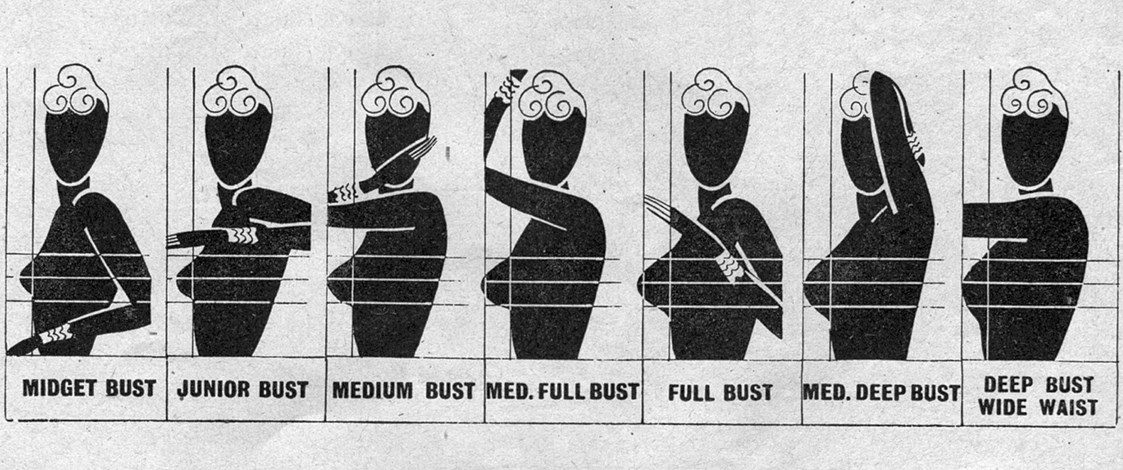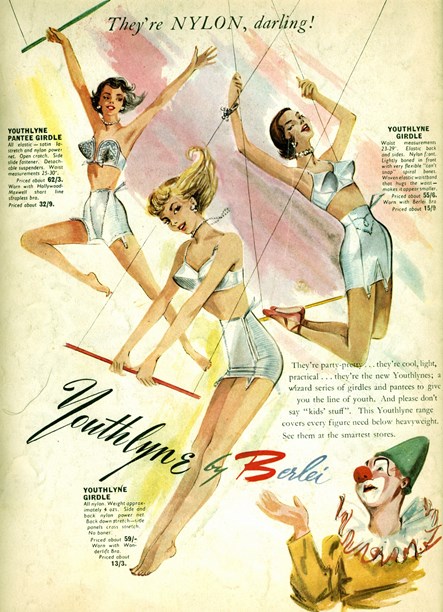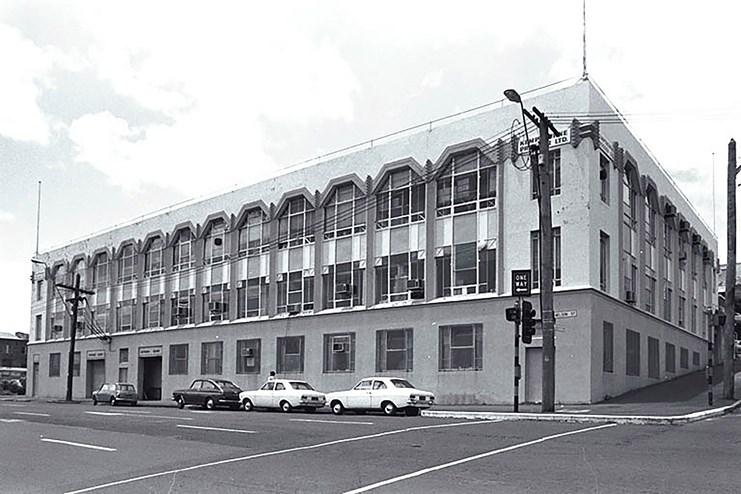Stories
Berlei
1923-

Berlei’s Figure Types revolutionised the 1920s corset industry; the standardised garment was replaced by variations designed to fit different 'figure types'.
The Berlei Company was founded in Australia in 1910 by two brothers, Frederick and Arthur Burley. Fred was the accountant at E Gover & Co, a small firm that manufactured women’s undergarments, when he decided to buy the controlling interest in the business. It became known as Unique Corsets until the brothers decided on Berlei - a version of their last name.
In 1913, Fred undertook a trip to Europe and the United States to study corsetry and to research different methods of manufacture and machinery. They grew the business quickly and by 1919 Berlei corsets were being sold in department stores across Australia and New Zealand, including Milne & Choyce in Auckland, C. Smith Ltd in Wellington and Mollison’s in Dunedin.
In 1923 six Australian staff members travelled to Auckland to open a New Zealand branch of Berlei. The company realised local production would reduce manufacturing costs and improve the service they could offer. The new industry was welcomed; the New Zealand Herald (20 November 1923) reported that the Department of Industries and Commerce supported the initiative by finding suitable premises for a factory.
The Herald wrote that Berlei aimed to supply women with corsets and brassiere, designed to give a "maximum of comfort and figure beauty". Interestingly the new Berlei staff include a female doctor whose role was to "see that the corsets are such as give assistance to women rather than discomfort". The Australian staff would be bolstered by "local girls".
In 1926 Frederick Burley collaborated with the University of Sydney to research the "true shape of women". He used the research findings to develop the 'five Berlei Figure Types' - used in the design process of Berlei garments.

The Berlei Type Indicator chart was used by fitters to determine a woman’s precise measurements. It was developed in 1926 after extensive research with the University of Sydney. Image courtesy of the Museum of Applied Arts & Sciences, Sydney.
Trained corsetieres from the company visited the department stores across New Zealand on a regular basis. There was great emphasis placed on wearing the right foundation garment. In 1930 the company decided to open a School of Corsetry in Auckland to train more corsetieres. Officially opened by the Mayoress of Auckland, more than 70 women attended the first week long course.
The Otago Daily Times (15 July 1930) wrote: "This subject is an art. Upon the degree of skill in its intricacies which a corset department assistant possesses, depends the satisfaction which one receives when choosing a foundation garment; This fact, stylists tell us, is even more important today than ever. First, because the mode today, which reveals natural figure lines, demands that even the most perfectly-proportioned figure be controlled and moulded. Secondly, a perfect-fitting foundation is absolutely essential if one would enjoy that support and uplift which gives poise and confidence throughout the actively-filled hours of our modern business or social life."
The form-fitting clothes of 1930s called for a slender figure and there was a big demand for figure-controlling garments that would eliminate bumps and bulges. It was a great time for corset manufacturers. In 1935, Berlei founded a separate company called Modaire which specialised in corsetry. 'Madame Modaire', an "expert figure specialist" fitted women in department stores all over New Zealand. Practical Front and Nu-Back were two corsets made by Modaire.
At this time Berlei’s product range expanded to include lingerie items with many intriguing names - Wrap-Ons, Controlettes, Step-In Belts, Maternity Belts and Berlettes. Most items were pink - the most popular lingerie colour of this time - and made in net, lace, voile and linen.
Some of Berlei’s innovative lingerie designs became classics. The Eezee – a two-way stretch sports foundation introduced in 1939 - was still being manufactured in the 1950s.
During World War Two, Berlei foundation garments were promoted as support for women during physical labour. Fabric shortages were also addressed in their advertising.
Berlei ads, 1944.
Skintex, a fabric equivalent of 'boning’, provided firm control for corsets, step-ins and corsolettes without the use of metal. "Skintex is as light as a sailor’s promise, yet firm as a step-aunt" read the promotional advertising.
The Princess Youth was a girdle and bra all-in-one. It was a traditional corsets without the bones, instead Berlei patented a back device which pulled in the waist.

Berlei Princess Youth advertisement, The Mirror, May 1934.
The arrival of nylon in the 1950s had a huge impact on the industry and by the end of the decade the Youthlyne range was utilising the power of 'nylon power net' in combination with elastic panels. The range of girdles, panty girdles and bras were designed for a younger market and advertisements featuring of mature women were replaced by partying teenagers.

Berlei Youthlyne advertisement, The Mirror, June 1953.
Above all Berlei promoted the concept of 'A Different frock, a different Berlei'. It was important to wear the right Berlei with the right outer garment. Women could order an illustrated booklet, Berlei Beauty, that explained what foundation garment should be worn under each type of clothing. In the 1960s and 1970s Berlei also manufactured swimwear.
Berlei’s first premises in New Zealand was on Lorne Street in Auckland but they soon outgrew this space. They purchased a property on the corner of Nelson and Wellesley Streets and American architect Roy Alstan Lippincott - who designed the extension to the Smith & Caughey’s building several years earlier - drew up the plans for a new factory and offices.
The New Zealand Herald (3 January 1931) reported the opening of Berlei House. "Berlei House is of three floors and has been constructed on the daylight principle, a maximum of natural light and air being obtained during the working day. It is thoroughly up to date, a feature being the modern stock rooms which ensure quick delivery to retailers. In the erection of their new factory the owners have made every consideration for the wellbeing and comfort of the staff, for whose use a magnificently fitted cafeteria and rest rooms have been provided."

Berlei House, on the corner of Wellesley and Nelson Streets in Auckland, circa 1970. Image from Sir George Grey Special Collections, Auckland Libraries, 435-B4-187.
A film made in 1935 depicts a visit to Berlei House. The film shows the work conditions for employees and demonstrates how the undergarments were manufactured, modelled and then despatched to various retail outlets.
Despite an extension to Berlei House in 1941, more space was required and a new factory was opened in Huntly in 1945. By 1955 three more factories had been opened in Te Aroha, Papatoetoe and Tokoroa - with a total staff of 550. Factories in Hamilton and Manurewa were established, the latter to house Laddaloc, lingerie manufacturer that Berlei acquired in 1962. By 1961 there were 662 employees in New Zealand.
In 1969 Berlei itself was acquired; and over the next few decades the Australia, New Zealand and British companies underwent a number of ownership changes. Auckland’s Berlei House was sold in 1973. But almost a century after the first Berlei factory opened in New Zealand, the brand is thriving. It continues to be stocked in department stores across the country.
Text by Kelly Dix. Banner image from The Mirror, December 1930.
First published January 2017, updated April 2020.